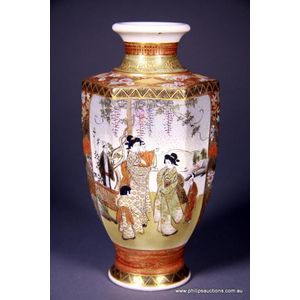1920s Satsuma vase with deity and male figure panels
You must be a subscriber, and be logged in to view price and dealer details.
Subscribe Now to view actual auction price for this item
When you subscribe, you have the option of setting the currency in which to display prices to $Au, $US, $NZ or Stg.
- Circa - A Latin term meaning 'about', often used in the antique trade to give an approximate date for the piece, usually considered to be five years on either side of the circa year. Thus, circa 1900 means the piece was made about 1900, probably between 1895 and 1905. The expression is sometimes abbreviated to c.1900.
- Crackling and Crackle as a Decorative Technique - Crackle, also known as crackling, is a decorative technique that has been used in China for centuries. It is believed to have originated during the Song Dynasty (960?1279 AD) and was primarily used in the production of ceramics, lacquerware, and furniture. The crackling effect was achieved by applying a glaze or lacquer that was formulated to crack during firing, creating a crackled pattern on the surface of the item.
During the Ming Dynasty (1368?1644 AD), crackle became a highly sought-after decorative technique, and it was used to create intricate and beautiful designs on ceramics and lacquer ware.
In Western decorative arts, crackle / crackling came into use during the Art Nouveau movement in the late 19th and early 20th century. The crackling effect was used to create a sense of movement and fluidity in the design of Art Nouveau pieces.
It was also used in the 1920s and 1930s during the Art Deco movement. - Crackles / Cracquelure - In ceramics, crackles may be introduced intentionally during the firing process, as was often the case with Oriental ceramics, and are known as artificial crackles. Natural crackles occur with age, and if the glaze is transparent, may be difficult to detect. Natural crackles may not cover the whole surface of the object and may be uneven in size.
This item has been included into following indexes:
- Japanese ceramics, factories and cities - Kinkozan 117
- Japanese ceramics, item types - other 2,525
-
Satsuma (Japan), item type
- figures and figurines 217
- other items 2,034
Visually similar items

A signed Satsuma vase, Meiji period, circa 1900, with signature of Seizan, the hexagonal baluster vase with a flattened collar, embellished with figural narrative scenes within cherry blossom and wisteria landscapes in colours and textured gilding, between

A Galle cameo glass vase, circa 1904 of tapering ovoid form, overlaid and acid etched with variegated purple chrysanthemums to yellow ground, signed in cameo Galle 29.2 cm high

A Satsuma vase by Ryokuzan, Meiji period, the ovoid body decorated in polychrome enamels and gilding with on one side maidens in a garden setting with distant view of Mt. Fuji, and the reverse with a twin duck-shaped panel enclosing a landscape and florett

Japanese Satsuma small vase, mark to base. Height 11 cm
